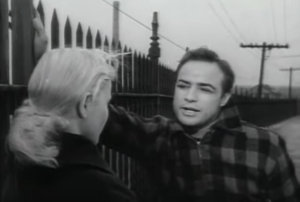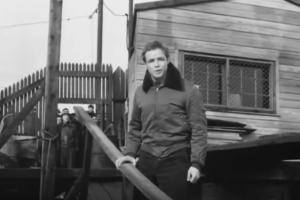In class, we had discussed the importance of fences and enclosed spaces in “On the Waterfront” in emphasizing the notion that the mob essentially “traps” people in a world of corruption. I decided to revisit some of the scenes of the movie to see how fences specifically influence and represent Terry’s character development.
The screenshot above was pulled from the scene in which Terry first initiates a legitimate conversation with Edie. We have learned that Edie has been sheltered from the reality of the corrupt world all of her life, and that she therefore represents both innocence and morality. This scene may represent Terry’s first step in crossing over to the free and stable society on the other side of the mob’s “fence.” Their conversation leading up this point has consisted of superficial small-talk surrounding Edie’s appearance when she was younger; however, once the conversation is brought over to the fence, Edie begins explaining the importance of “patience and kindness,” which are ideals most likely prominent on the other side of the barrier. As depicted above, if Terry continues to build his relationship with Edie and begins to make realizations about his corrupt society, the alternate and almost utopian world on the other side of the fence is right at his fingertips.
The mis-en-scene in the screenshot above evokes similar symbolism. Terry is visibly on the opposite side of the fence/cage as Edie, and there also seems to be some sort of cross-like figure behind Edie’s head. Clearly, the fence serves as a barrier between Terry and the morale, kind world that Edie is a part of. During their conversation, Terry asks Edie to go out for a beer with him, which shows his desire to break through the barrier and leave his corrupt world behind.
The screenshot above follows directly after Terry has a conversation with Father Barry about coming clean with Edie regarding her brother’s death. It is interesting to note that prior to making the decision to confront Edie, Terry was behind the fence – the barrier to morality. Once Father Barry instills in him the importance of being honest and breaking away from his forced loyalty to the mob, he finds his away outside the fence where he confesses to Edie. In other words, he has broken away from the corruption, and while he makes Edie upset, he is one step closer to entering her world.
The last symbolic fence that I took notice of was in one of the last scenes of the film as Terry confronts the mob leaders. In the background, it is clear that Terry had to pass through a unique fence structure; this action represents Terry officially leaving his corrupt lifestyle behind and putting his morale values over his loyalty to the mob. After seeing a shot of the entire dock (seen below), this fence seems very strategically and intentionally placed to make this point, as the fencing is not included along the entire dock.
Overall, I am incredibly fascinated by the thoughtful mis-en-scene in the film, especially the symbolic value of fences. This class has really opened my eyes to the small, but often incredibly significant details that directors and producers include in films to emphasize the overarching message. Zeroing in on these strategic choices really enhances the film-viewing experience.





